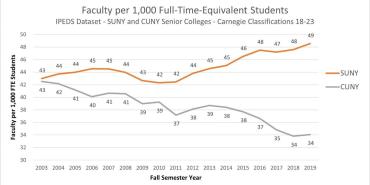A recent report has uncovered yet another case of racial disparity in education: Where there are more Black and Hispanic college students, there are fewer full-time faculty to go around.
Why is this so important? Research shows that more contact and engagement with faculty contributes to academic success, so those with less access are missing out. Full-time faculty have more time for mentoring and engaging in research and scholarship, the report notes. More full-time faculty also means more course sections available to students and the possibility of a greater variety of coursework.
The report, published by the City University of New York Faculty Senate, compares faculty-student ratios and racial data on 31 CUNY and State University of New York campuses. It finds that institutions with a majority of Black and Hispanic students have far fewer professors per student than institutions with a majority of white students.
Overall, CUNY students are 76.9 percent American Indian/Alaska Native, Asian/Pacific Islander, Black and Hispanic. The study shows students there have 34 faculty per 1,000 students. Meanwhile SUNY—with 28 percent students of color—has 49 faculty per 1,000 students.* The disparity exists when comparing campuses within one system—CUNY or SUNY—as well.
Comparing individual campuses, we see the gap can be even wider. At CUNY’s Medgar Evers College, for example, 91 percent of students are Black or Hispanic, and they have 33 full-time professors per 1,000 students. Compare that to SUNY Potsdam, where 26 percent of students are Black or Hispanic and have about 75 full-time professors per 1,000 students. CUNY’s York College has 65 percent Black or Hispanic students and 29 full-time faculty per 1,000, while SUNY Cortland has 19 percent Black or Hispanic students and 50 full-time faculty per 1,000.
The “opportunity for instruction by a full-time faculty member should be approximately the same regardless of the state-funded campus the student enrolls in,” says Ned Benton, the primary author of the report, a professor of public management at John Jay College of Criminal Justice/CUNY and a member of the Professional Staff Congress, the AFT affiliate at CUNY.
The report adds that this disparity is not only “educationally and morally unacceptable, it may also be illegal.” The Civil Rights Act of 1964 prohibits discrimination at institutions that receive federal funding—such as the Pell Grants many SUNY and CUNY students rely on.
“Brown vs. Board of Education and the Civil Rights Act of 1964 affirmed decades ago that unequal access to education for minority students is wrong,” wrote New York state Assembly Member Karines Reyes in a New York Daily News op-ed. “But the situation in our SUNY and CUNY senior colleges is like a school district that routinely provides fewer teachers to schools serving Black and Hispanic youngsters.”
To address faculty shortages, PSC, United University Professions (the AFT faculty-staff affiliate at SUNY) and legislators like Reyes are advocating for full funding of both university systems’ budget requests for more professors. The PSC has been leading the fight for the New Deal for CUNY, pressing for legislation that would increase the number of faculty and staff as well as provide for tuition-free postsecondary education and other measures to support student success at CUNY.
Both PSC and UUP are rallying for the state to close the “TAP gap,” the difference between the amount the state provides to colleges to support the education of low-income students through the Tuition Assistance Program and the actual amount of tuition. Since 2011, the colleges themselves have paid the difference, stretching institutions’ budgets and creating inequities on campuses where there are more students relying on TAP money.
“This union, UUP, wants to fix the TAP gap,” said UUP President Frederick Kowal at a recent rally for TAP gap funding. “We can change the world, we can make it just—but we need the resources.”
UUP also called for increasing faculty diversity in its 2021 New York HEALS plan, with the goal of having at least 25 percent of faculty and staff positions filled by individuals who are African American, Native American or Latino by 2025; it will be pressing that point in advocacy with legislators as the budget cycle begins in January. Currently, underrepresented races and ethnicities make up just 9 percent of SUNY faculty. The PSC also persistently presses for funding at its schools, where the majority of the students come from communities of color, many of them the first in their families to attend college.
Racial disparity in faculty-student ratios is just one way inequities are baked into the structure of higher education. “If we are looking for examples of systemic racism [faculty-staff ratios are] a very good example,” says Benton. He adds that he doesn’t think the results are intentional. But they are apparent, and harmful, nonetheless.
[Virginia Myers]
*The racial statistics include all CUNY and SUNY colleges; the faculty-student ratios cover nonspecialized baccalaureate and master’s degree colleges, excluding community colleges.
Editor’s note: Terms like Hispanic and Latino follow the terminology used in the data that is cited in the report and source materials.


